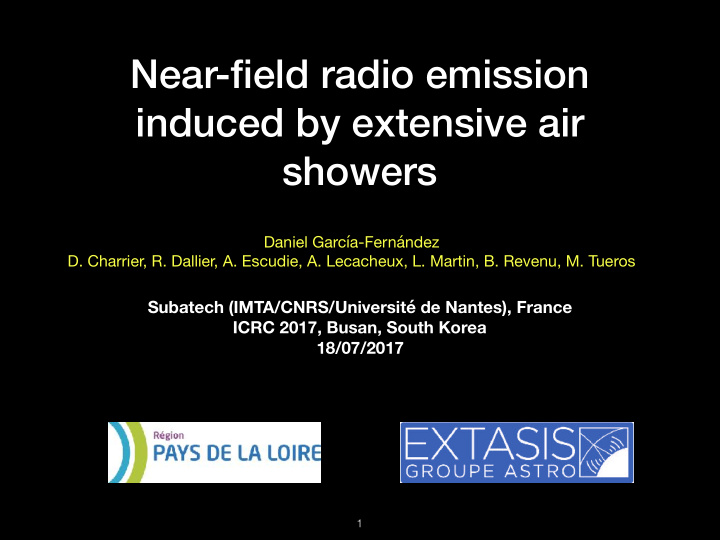



Near-field radio emission induced by extensive air showers Daniel García-Fernández D. Charrier, R. Dallier, A. Escudie, A. Lecacheux, L. Martin, B. Revenu, M. Tueros Subatech (IMTA/CNRS/Université de Nantes), France ICRC 2017, Busan, South Korea 18/07/2017 1
Take-home message • Low frequency (< 10 MHz) radio emission of EAS needs a new treatment including near-field e ff ects (d~ 𝛍 ) • We expect the existence of a new signal called the sudden death pulse (SDP) • We present a formula suitable for the calculation of the low-frequency electric field 2
Radio detection of cosmic rays (or neutrinos) • A primary particle creates an EAS • Charged particles in the EAS create electric field • Electric field is measured (usually > 20 MHz) 3
Why low frequency? • Several experiments (EASTOP , Akeno) have measured a large low-frequency emission (C. Castagnoli et al., 22nd ICRC, 363. // K. Nishi, K. Suga. Proc. 20th ICRC (1987) 125) • Simulations and measurements (see A. Escudie, [CRI102]) indicate an emission at low frequency with a larger detection range • We expect a new kind of signal, the sudden death pulse 450 - 500 kHz 2.3 - 2.9 MHz EASRADIO (EASTOP) Vertical polarisation 3.1 - 4.1 MHz Castagnoli et al., 22nd ICRC, 363 4
Sudden Death Pulse • Shower particles are Vertical component decelerated upon arrival to the ground • Large shower footprint, but coherence at low frequencies (1 MHz ~ 300 m) • Pulse at t = d/c after shower core arrival ArXiV:1211.3305 • Low-frequency pulse 5
The EXTASIS experiment • New experiment at the Nançay radio observatory • Detect the low-freq (1.7 - 3.7 MHz) counterpart to the known EAS field • Detect the SDP • See A. Escudie’s talk [CRI102] 6
Electric field for a track • Codes such as SELFAS, ZHAireS or CoREAS use the far-field approximation (kR >> 1) • At 1 MHz, and R = 100 m: kR ∼ 2. Near field! • Formula for the field of a particle track at all frequencies: • Caveat: Charge MUST be conserved! 7
Comparison with far-field: ZHS θ C + 10°. 1.2 m track, n = 1.78 • Our formula yields the same result as the ZHS formula (far- field). J. Alvarez-Muniz et al . Phys. Rev. D 81 (2010) 123009 R = 10 m • If charge is not conserved, pulses from the beginning and end of the track are not well reproduced. R = 100 m 1.2 m R θ C + 10° 8
Implementation in SELFAS • SELFAS (open source) is a MC code Vertical proton 1 EeV. 180 m altitude. < 5 MHz that calculates the field of an EAS. It SDP has been upgraded with a state-of- SDP the-art treatment of the atmosphere (see B. Revenu [CRI109]) (Vertical) • We have implemented our formula assuming: • No static field after shower extinction • Particles are suddenly stopped at ground level No SDP in this case (EW) • No reflection (can be taken into account with antenna pattern) or surface wave • No transmission (attenuation in soil) 9
Sudden Death Pulse amplitude • SDP amplitude calculated as a Vertical proton shower function of energy and distance Ground at 180 m altitude (vertical proton shower) • The amplitude is proportional to the energy (number of particles arriving to the ground) • At Nançay, we expect detectability between 1 and 10 µV/m Detection threshold 10
Low frequency emission at high altitude Vertical, 1 EeV proton shower • The amplitude is proportional to the energy (number of particles arriving to the ground) • Altitude closer to the shower maximum means larger SDP signal Altitude 2650 m (GRAND) • More total signal below 10 MHz! See spectrum. 11
Conclusions • We have presented an equation for the electric field of a particle track valid for all frequencies (includes near-field e ff ects) • Correctly taking into account near-field e ff ects is crucial for low frequency measurements (below 10 MHz). That is the case for the EXTASIS experiment. • We have implemented this formula in the SELFAS Monte Carlo code and checked its consistency with far-field (ZHS) calculations. • An analysis of the surface wave and the e ff ects of the interface on the field is underway. • Caveat: we have talked about electric field, not voltage. The response of the antennas in the near field could be complicated; only far-field properties are usually well known. 12
고맙습니다 Thank you 13
Low frequency emission at high altitude • The amplitude is proportional to the energy (number of particles arriving to the ground) • Higher altitude means larger SDP signal • More total signal below 10 MHz! See spectrum. Figure: 30 degrees 5 EeV proton shower Ground at 2650 m of altitude 14
Comparison with exact formula (frequency) • Our formula (above, in frequency domain) yields the same result as the exact formula in frequency domain in Phys. Rev D 87 (2013) 023003. • Therefore, the formula in time domain reproduces the complete electric field Figure: Cherenkov angle 1.2 m long track in ice, n = 1.78 15
Recommend
More recommend